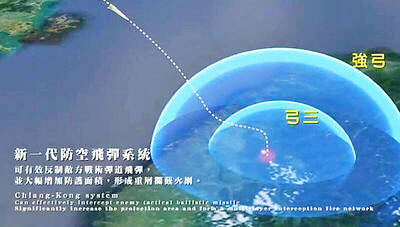Two US military aircraft reportedly flew close to the nation’s southern airspace yesterday, one day after the Ministry of National Defense confirmed that a Chinese People’s Liberation Army Navy (PLAN) aircraft carrier battle group sailed east of the country.
A US RC-135W Rivet Joint and a Lockheed P-3 Orion were operating in the South China Sea, according to flight charts posted on Twitter yesterday morning by Aircraft Spots, a military air movement tracker.
Based on the Twitter posts, the two planes flew at different intervals, with the RC-135W reconnaissance plane spotted first over the Bashi Channel, southwest of Taiwan.
Ministry spokesman Major General Shih Shun-wen (史順文) did not directly confirm the aircraft sightings, except to say the military is closely monitoring the nation’s surrounding waters and airspace.
According to charts released by Aircraft Spots and the ministry’s own records, the latest incident was the 10th time US aircraft have operated near the nation’s airspace since March 25.
The ministry on Sunday evening said that a PLAN aircraft carrier, the Liaoning, escorted by two destroyers, two frigates and a supply ship, were monitored as they passed through the Miyako Strait to the northeast of Taiwan on Saturday, headed south.
The flotilla passed to the east of Taiwan on Sunday as it moved southward on a long-range training mission, the ministry said, adding that no unusual activities were detected.
Su Tzu-yun (蘇紫雲), a senior analyst at the Taipei-based Institute of National Defense and Security Research, on Sunday said that Beijing has expanded its maritime and air presence in the Indo-Pacific region.
“This is probably the main reason US reconnaissance planes have recently been spotted operating near the Bashi Channel, to monitor the movements of the People’s Liberation Army in the area,” Su said.
Presidential Office spokesman Ting Yun-kung (丁允恭) on Sunday said the public has no need to worry about the nation’s safety and security.

LIMITS: While China increases military pressure on Taiwan and expands its use of cognitive warfare, it is unwilling to target tech supply chains, the report said US and Taiwan military officials have warned that the Chinese People’s Liberation Army (PLA) could implement a blockade within “a matter of hours” and need only “minimal conversion time” prior to an attack on Taiwan, a report released on Tuesday by the US Senate’s China Economic and Security Review Commission said. “While there is no indication that China is planning an imminent attack, the United States and its allies and partners can no longer assume that a Taiwan contingency is a distant possibility for which they would have ample time to prepare,” it said. The commission made the comments in its annual

DETERMINATION: Beijing’s actions toward Tokyo have drawn international attention, but would likely bolster regional coordination and defense networks, the report said Japanese Prime Minister Sanae Takaichi’s administration is likely to prioritize security reforms and deterrence in the face of recent “hybrid” threats from China, the National Security Bureau (NSB) said. The bureau made the assessment in a written report to the Legislative Yuan ahead of an oral report and questions-and-answers session at the legislature’s Foreign Affairs and National Defense Committee tomorrow. The key points of Japan’s security reforms would be to reinforce security cooperation with the US, including enhancing defense deployment in the first island chain, pushing forward the integrated command and operations of the Japan Self-Defense Forces and US Forces Japan, as

‘TROUBLEMAKER’: Most countries believe that it is China — rather than Taiwan — that is undermining regional peace and stability with its coercive tactics, the president said China should restrain itself and refrain from being a troublemaker that sabotages peace and stability in the Indo-Pacific region, President William Lai (賴清德) said yesterday. Lai made the remarks after China Coast Guard vessels sailed into disputed waters off the Senkaku Islands — known as the Diaoyutai Islands (釣魚台) in Taiwan — following a remark Japanese Prime Minister Sanae Takaichi made regarding Taiwan. Takaichi during a parliamentary session on Nov. 7 said that a “Taiwan contingency” involving a Chinese naval blockade could qualify as a “survival-threatening situation” for Japan, and trigger Tokyo’s deployment of its military for defense. Asked about the escalating tensions

INTERCEPTION: The 30km test ceiling shows that the CSIST is capable of producing missiles that could stop inbound missiles as they re-enter the atmosphere Recent missile tests by the Chungshan Institute of Science and Technology (CSIST) show that Taiwan’s missiles are capable of intercepting ballistic missiles as they re-enter the atmosphere and pose a significant deterrent to Chinese missile threats, former Hsiung Feng III missile development project chief engineer Chang Cheng (張誠) said yesterday. The military-affiliated institute has been conducting missile tests, believed to be related to Project Chiang Kung (強弓) at Pingtung County’s Jiupeng Military Base, with many tests deviating from past practices of setting restriction zones at “unlimited” and instead clearly stating a 30.48km range, Chang said. “Unlimited” restrictions zones for missile tests is